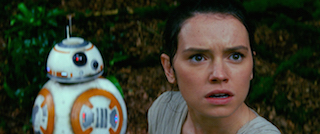 When J.J. Abrams and Dan Mindel, ASC, BSC took on Star Wars: The Force Awakens, they knew they were handling a cultural touchstone. As they did with Star Trek and Star Trek Into Darkness, they wanted to respect the antecedent while making a great, entertaining film for today’s audiences. So when it came to choosing format, lenses and the right look, they began by researching how the original Star Wars films were made.
When J.J. Abrams and Dan Mindel, ASC, BSC took on Star Wars: The Force Awakens, they knew they were handling a cultural touchstone. As they did with Star Trek and Star Trek Into Darkness, they wanted to respect the antecedent while making a great, entertaining film for today’s audiences. So when it came to choosing format, lenses and the right look, they began by researching how the original Star Wars films were made.
"J.J. asked me whether it was possible to find some of the original lenses,” says Mindel. “But even if it were possible, the film stocks and the visual effects techniques have changed, and the digital intermediate has come along as well. So in order to preserve the look and feel of those first three movies (Episodes IV, V and VI), I went to Panavision and asked them if they could manufacture me a set of lenses that I’d help design for the movie. And since I’m lifelong friends with those guys, it wasn’t really an issue. They were so pleased to do it.”
 So Mindel, first AC Serge Nofield and Panavision’s lens expert Dan Sasaki began an iterative process of experimentation using various recipes. The ingredients included the older anamorphic glass elements, their physical arrangement, and the multi-layered coatings applied to the elements. Color, the degree of softness, flare characteristics and the ergonomics of the lens were all factors.
So Mindel, first AC Serge Nofield and Panavision’s lens expert Dan Sasaki began an iterative process of experimentation using various recipes. The ingredients included the older anamorphic glass elements, their physical arrangement, and the multi-layered coatings applied to the elements. Color, the degree of softness, flare characteristics and the ergonomics of the lens were all factors.
Film stocks from the 1970s had completely different contrast and sharpness characteristics, which the lenses had to approximate in conjunction with today’s modern stocks. Another specification was that the lenses feel and weigh roughly the same as Primos, and work with standard follow-focus and accessories.
“That look is also a product of the way scenes are lit,” says Sasaki. “The coatings we applied gave the images certain warmth, and the space between the elements contributed to a different roll-off.
According to Sasaki, the undertaking was one of the most complicated in his vast experience. “Luckily, Dan gave us a lot of lead time to work it out, and was very patient,” says Sasaki. “He was specific – he wanted a 1970s-look lens, but he didn’t want any of the artifacts associated with ‘70s technology – edges that fall off at the top and bottom, for example. He wanted a classic, modern, reliable quality of lens, but a lens with personality to it that some of the older coatings and film technology back then offered. After many months and several attempts, we finally got that look.”
 Panavision started with C and B series cylinders, and developed a hybrid version that used some T Series technology. Current optics were used for the spherical components. Once the right combination was determined, it was applied to a full set – 35, 40, 50, 60, 75, and 100mm, with a minimum T-stop of 2.8. Once the right combination was determined, it was applied to a full set – 35, 40, 50, 60, 75, and 100mm. A couple of longer focal lengths were also adjusted slightly. Dubbed the Retro C Series, these lenses were on the camera for scenes featuring the brave Rebel Alliance, rendering a warmer, softer feel. New Order Stormtroopers were usually filmed with Panavision Primo glass for a harder, cooler look.
Panavision started with C and B series cylinders, and developed a hybrid version that used some T Series technology. Current optics were used for the spherical components. Once the right combination was determined, it was applied to a full set – 35, 40, 50, 60, 75, and 100mm, with a minimum T-stop of 2.8. Once the right combination was determined, it was applied to a full set – 35, 40, 50, 60, 75, and 100mm. A couple of longer focal lengths were also adjusted slightly. Dubbed the Retro C Series, these lenses were on the camera for scenes featuring the brave Rebel Alliance, rendering a warmer, softer feel. New Order Stormtroopers were usually filmed with Panavision Primo glass for a harder, cooler look.
“The level of forgiveness with the softer lenses is so beautiful,” says Mindel. “It will definitely affect the audience in a subconscious way.”
Some desert exteriors and effects plates were shot with 15-perf IMAX. On those shots, the lenses included T-2 80mm and T-2.8 50mm models refitted with Panavision mechanics and Panavision proprietary glass. These IMAX lenses had been originally developed for Wally Pfister, ASC on Christopher Nolan’s The Dark Knight.
Sasaki’s working relationship with Mindel goes back decades. “This was one of the more challenging shows for us, but what we’ve learned is priceless,” Sasaki says. “It opens up new doors, new ways of making lenses that react in different ways for artistic purposes. And with all the other subsequent Star Wars movies being planned, I have a feeling the results are going to be pretty spectacular.”
